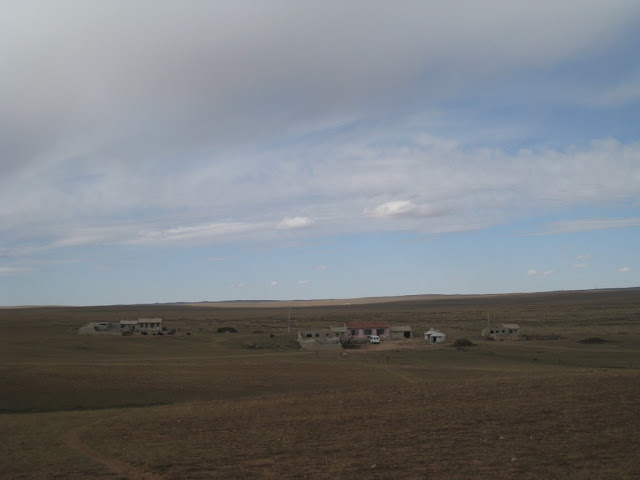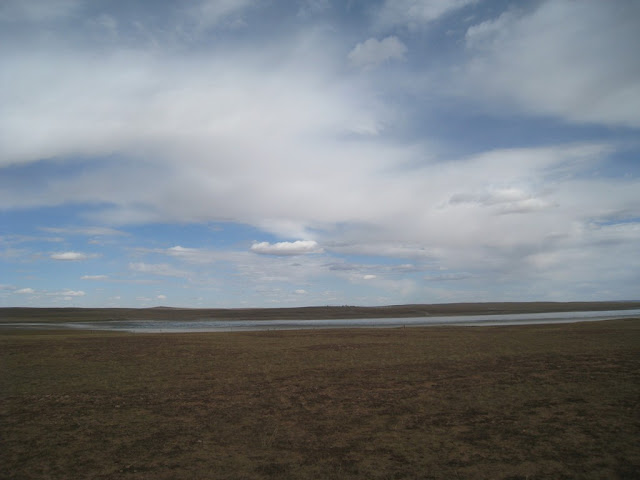View Inner Mongolia Trip in a larger map
Besides the grasslands, the next major thing to see in Inner Mongolia is the desert. Inner Mongolia is home to parts of the Gobi and other deserts. The desert occupies a large portion of land in that region. The nearest and most accessible section of the desert to the big cities in Inner Mongolia is called the Kubuqi Desert and everyone goes to the part called the Resonant Sand Gorge. To get to the desert, I went to the city Baotou, which is west of Hohhot. Before leaving Hohhot, I made sure to eat one last time on the restaurant street that had a lot of Mongolian and Muslim restaurants. Mongolian food and Muslim barbecue with lamb and spices is about as good as it gets for me.
Baotou isn't too far from Hohhot, but it definitely seemed a bit more wild and had less exposure to foreigners. Previously, when I went to a new and strange place, I'd get nervous or maybe feel a bit uncertain about things, but I've learned to embrace it and enjoy it as much as you can. After finding a hotel and booking my trip to the desert, I got a great dinner for the super cheap prices that can be found in the non-major Chinese cities.
Rack of Lamb
Bus Converted to Street Food Restaurant
The next day I headed to the Kubuqi desert. After taking about an hour and a half to two hours drive from Baotou, you reach an area of land that has a quick transition from farming area to sand and desert. I was shocked to see that literally within 100 meters of the desert they were building a huge rail line, which the driver said was mainly for shipping coal. Within the next 400 meter radius there was a huge coal electricity plant. To me it seemed like they were tempting the fates by building that kind of infrastructure right next to the desert. If the desert expanded to the point where it swallowed up the new rail line or destroyed their plant, there would be nothing they could do to stop it.
Coal Plant
Rail Line Next to Desert
People Getting a Ride on an Old Truck
For better or worse, the stretch of desert that they take everyone to is pretty touristy, but you don't really have a choice to go anywhere else. Before you enter the desert area, you can rent these big desert socks that keep sand out of your shoes. While they might not be the most fashionable, they are quite necessary if you plan on walking around much. Much like the grasslands, I had plenty of time to get out and do a little exploring on my own. I had never been to a desert landscape before and it was actually quite beautiful to see dunes stretched out as far as the eye can see.
Kubuqi Desert
My Driver
(He proves the stereotype that northern Chinese people are tall)
Wes and Stylish Red Desert Socks
Driver At Top of Dune
Desert Landscape

For more pictures, see the picasa album: http://picasaweb.google.com/wallred10/KubuqiDesertResonantSandGorge#
After walking around for awhile, I decided to partake in one of the tourist attractions and go on a camel ride. I had never ridden a camel before, so it was a good as time as any to give it a try. I have to admit that the camels were surprisingly docile and easy to ride. I'm not sure if it's because they are just good natured or if it's because they had bolts running through their noses connecting a string of camels together, but they definitely seemed friendly. Whereas the horses on the grasslands seemed to have a mind of their own, the camels just kind of plodded along wherever they were led.
Camel Corral
All Aboard (Notice Bolt Through Nose)
To get on the camel, you would climb on while the camel was lying down, then a Chinese guy helping you would kind of grunt and pull on the camel to get it to stand up. It was a surprisingly big jump to go from sitting to standing and normally the camels would stand up in stages: the back legs first, then the front legs. During the interval of time between when the back legs were going up and the front legs were still down, you would get rocked forward quite a bit, which caused quite a number of Chinese girls to scream.
After all the camels had been mounted in the group, one of the small, weathered Chinese men working there would lead the caravan for a walk around the desert. At first I thought those workers were friendly and helpful, that is until they demanded that you pay them when they took pictures of you on the camel. We rode the camels for about 20 minutes until we arrived at a little zoo, which mostly seemed to contain underfed and tortured animals that had no business living in the desert.

Tour Guide
Caravan
Wes on Camel
My Friendly Camel
Anyone Heard of Desert Goats?
These Animals Probably Died at this Zoo in the Desert
After the camel ride, I took some more time to walk around and see the desert landscapes.
Desert Landscape with Caravan in the Distance
Dune
There were a few other tourist things to do, like a long zip line and a sled down a big dune. Of course everything is overpriced for tourists, so I decided to take the cheaper sled ride and then headed back to the city. Upon arriving in Baotou, I went straight to the train station to go to my next destination, Datong, in Shanxi province. That means my time in Inner Mongolia was over. I really liked Inner Mongolia and enjoyed the landscapes of the grasslands and desert. It was nice to get away from big cities and pollution for a little while. The only thing that might have been nicer is if I had gone during the summer time. During the summer the grasslands would have been greener and the weather a bit warmer. Besides that, it was a great trip.
Here are some final scenes from Baotou and Inner Mongolia:
Man With Donkeys Pulling Cart Down Main Road
Back to Crowds of People at the Baotou Train Station
For more pictures, see the picasa album: http://picasaweb.google.com/wallred10/KubuqiDesertResonantSandGorge#





























































